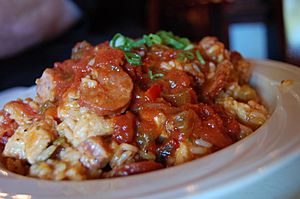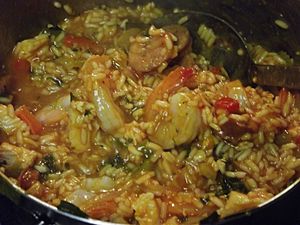Jambalaya facts for kids

Jambalaya with chicken, andouille sausage, rice, shrimp, celery and spices
|
|
| Alternative names | "Jumbled", "Mixed up" |
|---|---|
| Type | Rice |
| Place of origin | United States |
| Region or state | Louisiana |
| Main ingredients | Meats, vegetables, stock, rice, seasoning |
Jambalaya (pronounced JAM-buh-LY-uh) is a tasty rice dish from Louisiana in the United States. It's a mix of different cultures, including West African, French, and Spanish cooking styles. This dish usually has meat and vegetables all cooked together with rice.
Common meats in jambalaya include sausage (like smoked andouille sausage), pork, or chicken. Sometimes, seafood like crawfish or shrimp is added too. The vegetables often include a special mix called the "holy trinity" in Louisiana cooking. This means onion, celery, and green bell pepper. Other vegetables like okra, carrots, tomatoes, and garlic can also be used.
To make jambalaya, the meat and vegetables are first cooked until they are browned. Then, rice is added with different seasonings and broth. Everything cooks together in one pot until the rice is ready.
Jambalaya is a bit like other rice dishes from Louisiana, but it's also unique. For example, Gumbo uses similar meats and vegetables. But gumbo often has filé powder or okra, which are not common in jambalaya. Also, gumbo is usually served over white rice that is cooked separately. In jambalaya, the rice cooks right in the same pot with all the other ingredients.
Another dish, Étouffée, is a stew that always has shellfish like shrimp or crawfish. But it doesn't usually have the sausage found in jambalaya and gumbo. Like gumbo, étouffée is also served over rice that is cooked separately.
Jambalaya's roots come from several rice dishes found in West Africa, Spain, and France. These include Jollof rice from West Africa, paella from Spain, and a French dish called jambalaia from the Provence region.
Contents
Types of Jambalaya
There are two main ways to make jambalaya. The biggest difference is whether tomatoes are used or not.
Creole Jambalaya (Red Jambalaya)
This type is often called "red jambalaya" because it includes tomatoes. It's most common in and around New Orleans. To make it, meat (like chicken and sausage) is cooked with the "holy trinity" of celery, bell peppers, and onions. Then, other vegetables and tomatoes are added. After that, seafood might be included. Finally, rice and broth are added. The mixture is brought to a boil and then simmers (cooks slowly) until the rice is done.
Cajun Jambalaya (Brown Jambalaya)
This style is more common in the countryside of Louisiana. It does not use tomatoes. Instead, the meat is browned in a heavy pot, often made of cast iron. The browned bits that stick to the bottom of the pot give Cajun jambalaya its darker, brown color. The "holy trinity" vegetables are then added and cooked until soft. Next, broth and seasonings are added, and the meats are put back into the pot. This mixture simmers for a while. Finally, rice is added, and the dish cooks slowly until the rice is ready. This type often has a smoky and spicy flavor.
Other Jambalaya Styles
Sometimes, people make a "white jambalaya." In this method, the meat and vegetables are cooked separately from the rice. The rice is cooked in a flavorful broth on its own. Then, everything is mixed together before serving. This way of cooking jambalaya is not very common in Louisiana.
Many people, especially in Louisiana, also enjoy a simpler jambalaya. This style is cooked like Cajun jambalaya but without any vegetables. Some restaurants serve this version because it's often more appealing to children and has a smoother texture.
Most people in Louisiana think jambalaya is a hearty and fairly easy rice dish to make. Dishes like gumbo and étouffée are often seen as more challenging to get just right. Long-grain white rice is usually used for jambalaya.
A key difference between jambalaya and gumbo or étouffée is how the rice is cooked. In gumbo and étouffée, the rice is cooked separately and served as a base for the main dish. But in jambalaya, raw rice is added directly to the pot with the meat, vegetables, and broth. The rice then soaks up all the delicious flavors as it cooks.
History of Jambalaya
The story of jambalaya's creation has a few ideas. One idea is that it came from Jollof rice, a dish from West Africa. Many people who came to New Orleans from West Africa would have known about Jollof rice. Like jambalaya, Jollof rice was often made with whatever ingredients were available, such as seafood, crawfish, and different meats. Tomatoes are always part of Jollof rice.

Another popular idea is that jambalaya started in the French Quarter of New Orleans. It might have been an attempt by Spanish settlers to make their famous dish, paella, in the New World. However, saffron, a key spice for paella, was hard to get and expensive. So, tomatoes were used instead of saffron. Over time, French cooking styles became very popular in New Orleans. Spices from the Caribbean were also added, changing this New World paella into the unique dish we know today.
Cajun jambalaya comes from the rural, swampy areas of Louisiana. In these areas, ingredients like crawfish, shrimp, oysters, alligator, duck, turtle, wild boar, and venison were easy to find. Any mix of meats, including chicken or turkey, could be used. Cajun jambalaya is known for its smoky and spicy taste.
The word "jambalaya" first appeared in print in a poem written in a French dialect called Provençal in 1837. It later appeared in an American farming magazine in 1849. The first time a recipe for "JAM BOLAYA" was in a cookbook was in 1878.
Jambalaya became more popular in the 1920s and 1930s. This was partly because it was a flexible recipe. People could use whatever rice and vegetables they could afford, making it a dish that grew from simple beginnings.
In 1968, the Governor of Louisiana, John J. McKeithen, officially named Gonzales, Louisiana, the "Jambalaya capital of the world." Every spring, the town holds an annual Jambalaya Festival.
What Does "Jambalaya" Mean?
The word "jambalaya" likely comes from the Provençal word jambalaia. This word means a "mish-mash" or "mix-up," and it also refers to a rice dish similar to pilaf. This idea is supported by the fact that the word first appeared in a Provençal poem.
Some people think the word comes from two Spanish words: jamón (which means "ham") and paella (a rice dish). However, this idea is probably not true. Ham is not always the main ingredient in jambalaya. Also, Spanish speakers would say "paella with ham" differently.
Another idea, from Louisiana chef John Folse, is that jambalaya comes from "jambon à la yaya." This means "ham with rice," using the French word jambon for ham and the Yoruba word yaya for rice.
See also
 In Spanish: Jambalaya para niños
In Spanish: Jambalaya para niños



